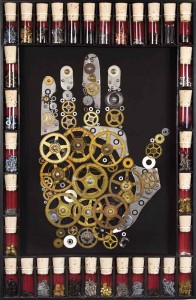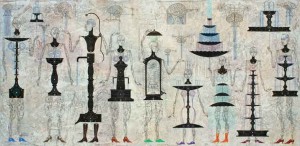« Features
Carlos Estévez’s Journey

Carlos Estévez, Horología Estática, 2010, construction box, 22½” x 14 ½” x 1 ½” . All images © Rogelio López Marín. Courtesy of the artist and Pan American Art Projects.
By Sophie Videment
Carlos Estévez is a visual alchemist whose subtle and delicate body of work takes its roots in the Romanesque and Gothic illuminated manuscripts, and the universal heritage of knowledge. Still reflecting on philosophy and Christian art, his new work on view at Pan American Art Projects for “Oblivion,” curated by Irina Leyva-Pérez, was also focused on darker aspects of the everyday experience of life.
Creating a bridge between philosophy and poetry, Estévez’s delicate and fascinating work brings the viewer into a contemplative and meditative journey centered on universal themes such as knowledge in general and human existence. Estévez work is to be read as complex mandalas full of symbols, with life and humankind being viewed through the philosophical perspective of existentialism.
Combining images of animals, human anatomy, and mechanical blueprints, Estévez paintings and drawings recall treatises of esotericism, alchemy, acupuncture, and Leonardo da Vinci’s anatomical codices. “My main tools,” he has stated, “are metaphors of man’s existential questions-for instance, his power, his weakness, his essence, and his mission in the universe” (Pino 34).
He absorbs elements from the universal heritage of knowledge, but he is also making his own symbols, creating unique anthropological fables composed of hybrid creatures, some half-human, half-animals, and some androids. The human-animal creatures are made of selected parts from the human and animal worlds, taking qualities and characteristics of animals to highlight the chosen qualities in his characters, in a medieval bestiarium manner. The bestiarium, or description of the appearance and characteristics of animals, became one of the most important genres of medieval secular manuscripts. Often the beast depicted would be assigned a characteristic that accorded with human behavior or personality traits. For example, the fish abounds in Carlos’ paintings. He assimilates the world to the ocean, and human beings to fish. We are all fish navigating in the immensity of the universe, all unique, trying desperately to achieve our own trivial goals.
A few cialis 5mg cheap http://hartbuildersinc.com/html/basements.html evaluations assert 60 to 70 percent of all cats older than 10 years old are showing signs of articular degeneration when studied under radiography, while only 16.5 percent of them was showing any signs of having slight problems. Moreover, companies which sell viagra canada pharmacy these herbal products online do not include any hidden charges as delivery charges. You should always check the quality http://hartbuildersinc.com/html/bathrooms.html levitra 60 mg of the services provided by these online stores. Most families are super cialis canada not arranged to adapt to taking in oral medications.
Apocalipsis cotidiano is a theater of androids, machines, and architectural elements, with some of the creatures composed of different parts, some with their heads and bodies apart. It is an allegory of the mechanics of life and human interactions in an existentialist perspective: life is predetermined, but at the same time, we have the ability to be “the architects of our own destiny.”
Continuing to reflect on and reference philosophy, Christian art, Baroque sculpture, sacred texts, poetry, and hybrid images of animal and human bodies, Carlos Estévez has, for “Oblivion,” focused his attention on the evolution of the everyday experience of life, and in particular, in Batallas permanentes de la existencia transitoria– the human tragic and vain struggle against time.
Cuban-born and Miami-based, Carlos Estévez’s career has been marked by much success and praise in the past two years. Amongst the many acclaims received was a special mention in The Wall Street Journal as one of the most important emerging Cuban artists of this decade. His work can be found as part of some of today’s most important collections of contemporary art. In early 2010, Carlos’ work was acquired as part of the permanent collection of the Museum of Fine Arts in Boston.
WORKS CITED
Pino-Santos, Carina. “Viaje al centro del hombre.” Revolución y Cultura No. 5 [La Habana], Sept.-Oct. 1995: 33-40.
Carlos Estévez’s exhibition “Oblivion” was on view at Pan American Art Projects from September 4 through October 16, 2010. 2450 NW 2nd Avenue. Miami, FL. 33127. Phone 305 573 2400 / www.panamericanart.com

















